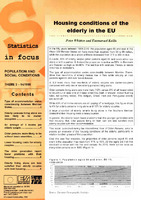| dc.description.abstract | In the fifty years between 1960-2010, the population aged 65 and over in the fifteen EU Member States will have more than doubled, from 34 to 69 million, while the population as a whole will have increased from 315 to 385 million. EU-wide, 83% of elderly people (older persons aged 65 and over) either live alone or with a partner. In Ireland the proportion is as low as 69%, in Denmark and Sweden as high as 94-96%. The rest live with relatives, friends or reside in homes or institutions. The type of accommodation varies considerably between Member States. More than two-thirds of elderly Italians live in flats while virtually all Irish persons aged 65 and over live in houses. At EU level, more than two-thirds of elderly couples are owner-occupiers compared with only one in two elderly persons living alone. Older persons living alone are more likely (12% versus 5% of all households) to be without at least one of 3 basic amenities (bath or shower, indoor flushing toilet, hot running water). The Belgian, Greek, Irish and Portuguese elderly are worst-off. While 43% of all home-owners are still paying off a mortgage, this figure drops to 4% for elderly persons living alone and 10% for elderly couples. A large proportion of elderly tenants living alone in the Southern Member States find their housing costs a heavy burden. In general, the elderly report fewer problems than the younger generation with their housing. But, older people living on their own are less satisfied than elderly couples with their accommodation. |

